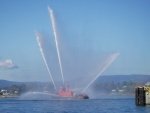I have witnessed several boats explode and burn at fuel docks, as well as several other propane explosions--some with fire and some not.
In this case:
Just before 3:35 p.m. Chief Fire Marshal Walter Seely said a man in a 24 1/2 -foot 1978 Sea Ray power oat with an inboard engine had just finished fueling at the Hinkley Yachts dock.
When the man turned on his engine to leave, the boat exploded in flames. The man and his passenger were able to evacuate the burning vessel before it was cast off from the dock and into the harbor, Seely said.
A classic case of someone fueling his boat, and not checking the bilge before starting the engine--no matter if he says he ran a blower or not. When I had an inboard gasoline boat, we always had all people off the boat when fueling, opened the hatch and put our head into the engine compartment to sniff for fumes, then ran the blower for 5 minutes, sniffed again and then started the engine.
According to the news sources it took fire dept about 25 minutes to get on scene. There eventually was a fire boat as evidenced in other short video segments. But unless a fire fighting unit is on scene other boats often are lost.
If the fellows in the inflatable had a small folding grapnel type of anchor, with a light chain on it, they could have thrown it into the cockpit of the burning boat and kept it form drifting into docks. Alternaternatively the boats at the leeward dock could have been cut loose and pushed off and the inflatable pulled them clear.
I watched in Pensacola when we had a very intense fire in one of the "shed" wooden structure with tin roof, marinas. The fire was started by a "mechanic" who was working on a diesel boat, spraying WD 40 on a warm engine part and then attempted to start the engine. The engine compartment items on a diesel boat are not ignition protected as on a gas boat. The fire burned a dozen boats and did several million worth of damage. The nearest fire hydrant was over 300' away so several hoses had to be strung out and a pumper moved to near the fire to get pressure needed. All of this is complicated by the entrapment of fire, heat and smoke in the "shed" and makes it difficult for the fireman to get water on the fire. A small CG "Safe boat" had responded and attempted to pull a boat which had broken free and was drifting toward waterfront homes with a grapnel on a nylon line. The line burned and they didn't have another grapnel. Afterward the sheds were rebuilt in a more fire safe manor, fire mains were put on the docks. and hoses were available. The City did acquire some type of small fire boat. (But it was not regularly staffed).
Many marinas are not equiped to high fires. Some are, with fire mains, and hoses on the docks. In Long Beach, CA, we had a fire station in the marina. (No longer) with a catamaran fire boat. (Fast with little wake and stable. Fire fighters trained specifically to fight fires). The Baywatch series of boats of Los Angeles County had a fire fighting turret on the fore deck and can be effective fire fighting vessels.
Fortunatel no lives appeared to be lost, and we all need to focus on our safety when fueling!
Thanks Jason

 . I doubt that could be gotten out of the way. The "after photo" which I could not copy showed an intact hull--could not tell about the motor, but it was probably toast also!
. I doubt that could be gotten out of the way. The "after photo" which I could not copy showed an intact hull--could not tell about the motor, but it was probably toast also! 